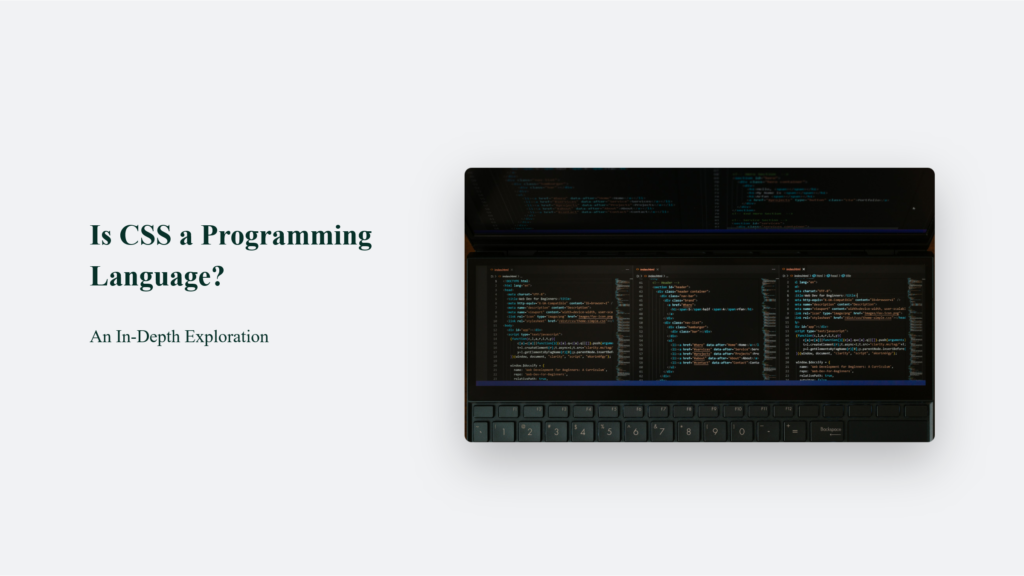The debate over whether Cascading Style Sheets (CSS) is a programming language has echoed through the corridors of web development communities for years. At the heart of this discussion lies the distinction between programming languages, designed to carry out computations and perform tasks, and CSS, which primarily focuses on styling and presenting content on the web. This article delves into the intricacies of is CSS a programming language, offering insights, examples, and key takeaways to shed light on its classification.

Key Takeaways
- CSS is Essential but Not a Traditional Programming Language: It is a stylesheet language aimed at designing the visual presentation of web pages, not performing computations or logical operations.
- The Evolution of CSS: With features like media queries, variables, and functions, CSS is evolving, displaying characteristics reminiscent of programming languages.
- Practical Implications Over Definitions: Whether or not CSS is classified as a programming language may matter less than the practical implications of its use in web development.
Is CSS a Programming Language?
Cascading Style Sheets (CSS) is a styling language that forms a fundamental trio with HTML and JavaScript, defining web pages’ visual and auditory layout. CSS describes how HTML elements should be displayed, controlling layouts, colour schemes, typography, and more, making it a critical tool for web designers and developers.
The Role of CSS in Web Development
CSS’s role extends beyond mere aesthetics; it’s crucial for creating responsive designs that adapt to various devices, improving user experience, and ensuring accessibility. By separating content from design, CSS enables cleaner HTML code, enhancing the site’s performance and maintainability.
How CSS Works
CSS works by selecting elements in an HTML document and applying their styles. These styles can be defined within the HTML document, linked from an external stylesheet, or included in a separate file imported into the HTML. This flexibility allows developers to apply consistent styling across multiple website pages efficiently.
The Evolution of CSS
Since its inception in 1996, CSS has evolved through several versions, each introducing new features and capabilities. CSS3, the latest version, brought advances such as gradients, transitions, animations, and flexbox and grid layouts, significantly expanding web design and interactivity possibilities.
CSS Frameworks and Preprocessors
The development community has built on CSS’s foundation with tools like preprocessors (e.g., Sass, Less) and frameworks (e.g., Bootstrap, Tailwind CSS). Preprocessors add functionality to CSS with variables, mixins, and nested syntax to write more powerful and maintainable code. Frameworks provide pre-written CSS classes to speed up development and ensure consistency and responsiveness across web projects.
Importance of CSS in Modern Web Development
CSS is indispensable in modern web development for several reasons:
- Responsive Design: CSS media queries enable websites to adapt their layout and design to different screen sizes, improving usability and accessibility.
- Performance and Optimization: Efficient CSS can significantly improve page loading times and website performance.
- Cross-Browser Compatibility: CSS ensures that websites look consistent across browsers, enhancing the user experience.
- Customization and Themes: CSS allows for easy customization and theming of websites, enabling brands to align their web presence with their visual identity.
The Programming Language Debate:
The debate around whether CSS (Cascading Style Sheets) can be considered a programming language hinges on its capabilities and features that overlap with traditional programming languages despite its primary function as a stylesheet language designed for styling HTML documents.
Presentation vs. Functionality
Core Function: CSS is fundamentally a stylesheet language, distinct from programming languages like JavaScript, Python, or PHP, which are equipped for full-scale programming. CSS’s primary role is to dictate the visual presentation of web content, not to perform logical or computational operations.
Programming Features in CSS: Despite its focus on presentation, CSS includes features that suggest programming-like capabilities:
- Conditional Statements (Media Queries): Allow for applying different styles under specific conditions, such as screen size, resembling the conditional logic in programming languages.
- Variables (Custom Properties): Provide a way to store values that can be reused throughout a document, a feature commonly associated with programming.
- Functions (calc()): CSS’s calc() function permits basic mathematical operations within style definitions, enabling dynamic calculations of values.

Advancements and Blurring Lines
CSS Preprocessors: Tools like SASS or LESS extend CSS’s capabilities significantly, introducing features such as variables, mixins, nested rules, and more, which are compiled into standard CSS. These preprocessors add a layer of complexity and functionality that moves CSS closer to traditional programming paradigms. By requiring a compilation step, these tools highlight the evolving nature of CSS from purely stylistic to a more dynamic and functional role in web development.
Turing Completeness
A key argument in programming language classification is Turing completeness – the ability of a system to perform any computation given enough time and resources. While CSS, in combination with HTML, is Turing complete under specific conditions, this is more of a theoretical curiosity than a practical application.
Examples That Illustrate CSS’s Capabilities
- Responsive Design: Media queries in CSS allow for responsive designs that adapt to different screen sizes, an essential aspect of modern web development.
- Dynamic Styling: CSS variables enable themes and dynamic styling that can be manipulated through user interactions.
- Complex Layouts: Grid and Flexbox layouts demonstrate CSS’s ability to handle complex web page layouts without the need for traditional programming logic.
The Bottom Line:
In conclusion, while the debate over CSS’s status as a programming language is intriguing, it ultimately serves as a testament to its power and versatility in the web development ecosystem. Its role in shaping the visual aspect of the internet is undisputed, making it an invaluable skill for developers and designers alike. Whether or not it’s labelled a programming language, CSS’s significance in creating engaging, dynamic web experiences is undeniable.
Frequently Asked Questions:
Can CSS exist on its own?
No, CSS is designed to style HTML documents. It cannot function independently as it requires a markup language to apply styles to.
Is learning CSS worthwhile for aspiring developers?
Absolutely. CSS is essential for web development, enabling the creation of visually appealing, responsive websites. It’s a foundational skill for front-end developers.
Can CSS perform calculations?
Yes, CSS can perform basic mathematical calculations using the calc() function, allowing dynamic sizing and positioning.




